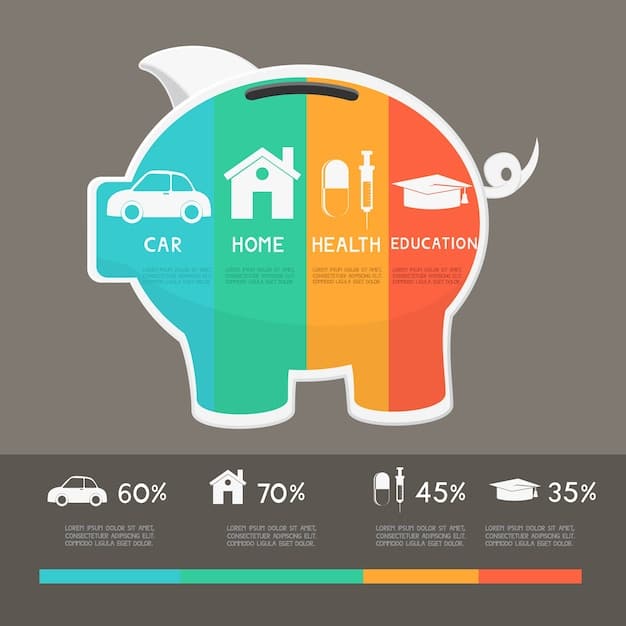Fed Rate Hike 2025: Refinancing Impact & Mortgage Options

A projected 0.75% interest rate hike by the Federal Reserve in early 2025 will likely increase mortgage rates, making refinancing less attractive for some homeowners but potentially beneficial for others depending on individual financial circumstances and existing mortgage terms.
Are you pondering a mortgage refinance in 2025? The Federal Reserve’s expected interest rate adjustments could significantly influence your options. Understanding how the Federal Reserve’s projected 0.75% interest rate hike in early 2025 will impact your mortgage refinancing options is crucial for making informed financial decisions.
Understanding the Federal Reserve’s Interest Rate Decisions
The Federal Reserve, often called the Fed, plays a pivotal role in shaping U.S. economic policy. One of its primary tools is adjusting the federal funds rate, which influences borrowing costs across the economy. Understanding these decisions is vital for anyone involved in personal finance, especially when thinking about a mortgage.
What is the Federal Funds Rate?
The federal funds rate is the target rate that the Federal Reserve wants banks to charge one another for the overnight lending of reserves. This rate serves as a benchmark for many other interest rates, including those on mortgages, credit cards, and savings accounts. When the Fed raises this rate, it becomes more expensive for banks to borrow money, which then gets passed on to consumers and businesses in the form of higher interest rates.
Why Does the Fed Adjust Interest Rates?
The Federal Reserve adjusts interest rates to manage inflation and promote full employment. When inflation is high, the Fed may raise interest rates to cool down the economy by making borrowing more expensive, which in turn reduces spending. Conversely, when the economy is sluggish, the Fed may lower interest rates to encourage borrowing and investment, thereby stimulating economic growth.
- Inflation Control: Raising rates can curb spending and slow down inflation.
- Economic Stability: Lowering rates can stimulate borrowing and boost economic growth.
- Employment: The Fed aims to maintain a healthy job market.
In conclusion, understanding the Federal Reserve’s role in setting interest rates is essential for comprehending how these decisions affect various aspects of personal finance, including mortgage refinancing. With the projected rate hike in early 2025, it’s prudent to assess your refinancing options carefully.
How Interest Rate Hikes Affect Mortgage Rates
When the Federal Reserve increases the federal funds rate, it typically leads to an increase in mortgage rates. This is because mortgage rates are closely tied to the 10-year Treasury yield, which often moves in tandem with the federal funds rate. A higher federal funds rate makes borrowing more expensive for banks, and they, in turn, pass those costs on to consumers in the form of higher mortgage rates.
Direct Impact on Fixed-Rate Mortgages
For fixed-rate mortgages, the impact of a rate hike is usually seen in new loans. If you’re considering refinancing into a new fixed-rate mortgage after the Fed raises rates, you can expect to see higher interest rates compared to what was available before the hike. This could make refinancing less attractive unless you have a compelling reason to do so, such as shortening the loan term or consolidating other debts.
Variable-Rate Mortgages and Adjustments
Variable-rate mortgages (ARMs) are even more directly affected by interest rate hikes. These mortgages have interest rates that adjust periodically based on a benchmark rate, such as the prime rate or the LIBOR (though LIBOR is being phased out). As the Fed raises rates, these benchmark rates typically increase, leading to higher monthly payments for ARM borrowers. If you currently have an ARM, a rate hike could mean a noticeable increase in your mortgage costs.

In summary, interest rate hikes by the Federal Reserve tend to push mortgage rates upward, affecting both new fixed-rate mortgages and existing variable-rate mortgages. This is an important factor to consider when evaluating your refinancing options.
Assessing Your Current Mortgage Situation
Before making any decisions about refinancing, it’s important to take a hard look at your current mortgage. Understand the terms, interest rate, and any penalties you might incur by refinancing. This assessment will help you determine if refinancing is a financially sound move.
Understanding Your Current Mortgage Terms
Start by reviewing your current mortgage documents. Pay close attention to the interest rate, loan term, and any prepayment penalties. Knowing these details will give you a baseline for comparison when considering refinancing options. Also, check if your mortgage has an adjustable rate, as this could change with the Fed’s actions.
Calculating Your Break-Even Point
Refinancing involves costs, such as appraisal fees, origination fees, and closing costs. Calculate how long it will take for the savings from a lower interest rate to offset these costs. This is your break-even point. If you plan to move before reaching this point, refinancing may not be worth it.
- Interest Rate: What is your current interest rate?
- Loan Term: How many years do you have left on your mortgage?
- Prepayment Penalties: Are there any penalties for paying off your mortgage early?
In conclusion, a thorough assessment of your current mortgage situation is crucial before considering refinancing. Knowing the terms, understanding the costs, and calculating your break-even point will help you make an informed decision.
Refinancing Strategies in a Rising Rate Environment
Refinancing in a rising rate environment requires careful planning. While it might seem counterintuitive, there are situations where refinancing can still be beneficial, such as shortening your loan term or switching from an adjustable-rate to a fixed-rate mortgage.
Shortening Your Loan Term
One potential benefit of refinancing in a rising rate environment is the opportunity to shorten your loan term. While the interest rate might be slightly higher than what was previously available, shortening the term can save you a significant amount of money in interest over the life of the loan. This strategy works best if you can afford the higher monthly payments that come with a shorter term.
Switching from an ARM to a Fixed-Rate Mortgage
If you currently have an adjustable-rate mortgage (ARM), refinancing to a fixed-rate mortgage can provide stability and protect you from future rate increases. Even if the fixed rate is higher than your current ARM rate, the peace of mind that comes with knowing your rate won’t change can be worth the cost.

In summary, while rising rates can make refinancing less attractive, there are strategies you can use to still benefit. Shortening your loan term or switching from an ARM to a fixed-rate mortgage can provide long-term savings and stability.
Exploring Alternative Mortgage Options
If traditional refinancing doesn’t seem like the right fit, there are alternative mortgage options to consider. These include home equity loans, lines of credit, and government-backed programs.
Home Equity Loans and Lines of Credit
Home equity loans and lines of credit (HELOCs) allow you to borrow against the equity you’ve built in your home. These can be used for various purposes, such as home improvements or debt consolidation. However, they also come with risks, including the possibility of losing your home if you can’t repay the loan. While HELOC rates may be above current mortgage rates, they give flexibility and access to capital when needed.
Government-Backed Programs
Government-backed programs, such as those offered by the Federal Housing Administration (FHA) and the Department of Veterans Affairs (VA), can provide more flexible refinancing options for eligible borrowers. These programs often have lower interest rates and easier qualification requirements than traditional mortgages. They’re designed to help homeowners who might not otherwise qualify for a refinance.
- FHA Loans: Insured by the Federal Housing Administration, these loans are available to borrowers with lower credit scores and down payments.
- VA Loans: Guaranteed by the Department of Veterans Affairs, these loans are available to veterans, active-duty military personnel, and eligible surviving spouses.
- USDA Loans: Offered by the U.S. Department of Agriculture, these loans are available to borrowers in rural areas.
In conclusion, if traditional refinancing options are limited, exploring home equity loans, lines of credit, and government-backed programs can provide alternative solutions. Each option comes with its own set of benefits and risks, so it’s important to carefully evaluate your financial situation and goals before making a decision.
Preparing Your Finances for Refinancing
Regardless of the interest rate environment, preparing your finances is crucial for a successful refinance. This includes improving your credit score, reducing your debt-to-income ratio, and gathering all necessary documentation.
Improving Your Credit Score
A higher credit score can help you qualify for a lower interest rate. Review your credit report for any errors and take steps to improve your score, such as paying down debt and making timely payments. Even a small improvement in your credit score can make a big difference in the interest rate you receive.
Reducing Your Debt-to-Income Ratio (DTI)
Your debt-to-income ratio (DTI) is the percentage of your gross monthly income that goes towards paying debts. A lower DTI indicates that you have more disposable income, which makes you a less risky borrower. Pay down debts to reduce your DTI and improve your chances of getting approved for a refinance.
In summary, preparing your finances is a critical step in the refinancing process. Improving your credit score, reducing your debt-to-income ratio, and gathering all necessary documentation can increase your chances of getting approved for a refinance at a favorable interest rate.
| Key Points | Brief Description |
|---|---|
| 💰 Fed Rate Hike Effect | Increases mortgage rates; affects refinancing attractiveness. |
| 📊 Assess Current Mortgage | Evaluate terms, calculate break-even point before refinancing. |
| 🛡️ Refinancing Strategies | Consider shortening loan term or switching from ARM to fixed. |
| 🏦 Alternative Options | Explore home equity loans or government-backed programs. |
Frequently Asked Questions
If you have a fixed-rate mortgage, a Fed rate hike won’t directly impact your interest rate or monthly payments. However, those with adjustable-rate mortgages (ARMs) may see their rates increase.
It depends on your financial goals. If you can shorten your loan term, switch from an ARM to a fixed rate, or tap into home equity for a beneficial purpose, refinancing might still be worthwhile.
Generally, a credit score of 740 or higher is considered excellent and will qualify you for the best refinance rates. However, some lenders may offer competitive rates to borrowers with scores in the 600s.
Closing costs typically range from 2% to 5% of the loan amount. These costs can include appraisal fees, origination fees, title insurance, and recording fees. It’s essential to factor these into your refinancing decision.
To lower your debt-to-income ratio, focus on paying down outstanding debts, such as credit card balances and personal loans. Increasing your income through a raise or side hustle can also help.
Conclusion
Navigating the complexities of mortgage refinancing in anticipation of a Federal Reserve interest rate hike requires careful consideration and strategic planning. By understanding the potential impacts, assessing your current financial situation, and exploring alternative options, you can make informed decisions that align with your long-term financial goals.





